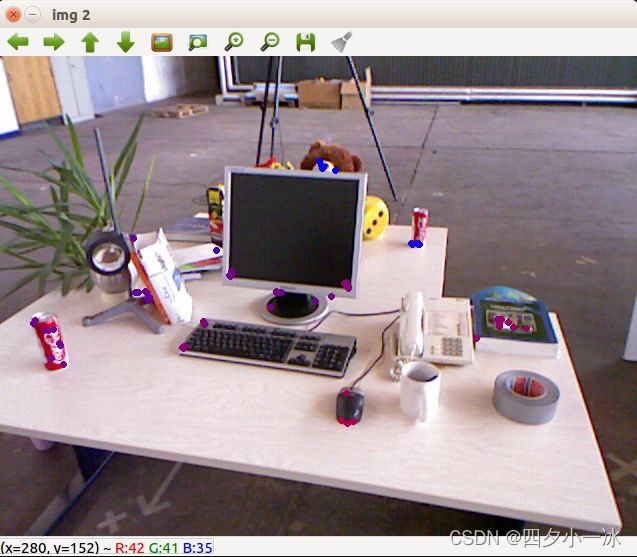视觉SLAM十四讲笔记-7-3
视觉SLAM十四讲笔记-7-3
文章目录
- 视觉SLAM十四讲笔记-7-3
-
- 7.5 三角测量
- 7.6 实践:三角测量
-
- 讨论
7.5 三角测量
之前两节使用了对极几何约束估计了相机运动,也讨论了这种方法的局限性。在得到运动之后,下一步需要用相机的运动估计特征点的空间位置。在单目SLAM中,仅通过单张图像无法获得像素的深度信息,需要通过三角测量(Triangulation)(或三角化)的方法估计地图点的深度。

三角测量是指,通过不同位置对同一个路标点进行观察,从观察到的位置推断出路标点的距离。三角测量最早由高斯提出并应用于测量学中。在SLAM中,主要用三角测量来估计相机像素点的距离。
和上一节类似,考虑图像 I 1 I_1 I1 和 I 2 I_2 I2,以左图为参考,右图的变换矩阵为 T T T。相机光心为 O 1 O_1 O1 和 O 2 O_2 O2。在 I 1 I_1 I1 中特征点 p 1 p_1 p1,在 I 2 I_2 I2 中特征点 p 2 p_2 p2。理论上,直线 O 1 p 1 O_1p_1 O1p1 与 O 2 p 2 O_2p_2 O2p2 在场景中会交于一点 P P P,该点即两个特征点所对应的地图点在三维场景中的位置。然而由于噪声的问题,这两条直线往往无法相交。因此,可以通过最小二乘法求解。
按照对极几何中的定义,设 x 1 x_1 x1, x 2 x_2 x2 为两个特征点的归一化坐标,它们之间满足:
s 2 x 2 = s 1 R x 1 + t s_2x_2 = s_1Rx_1 + t s2x2=s1Rx1+t
现在已知 R , t R,t R,t,想求解两个特征点的深度 s 1 s_1 s1, s 2 s_2 s2。从几何上看,可以在射线 O 1 p 1 O_1p_1 O1p1 上寻找 3D 点,使其投影位置接近 p 2 p_2 p2。同理,也可以在 O 2 p 2 O_2p_2 O2p2 上找,或者在两条线的中间找。
不同的策略对应着不同的计算公式,当然它们大同小异。例如,希望计算 s 1 s_1 s1,那么先对上式两侧左乘一个 x 2 ∧ x_2^\wedge x2∧,得:
s 2 x 2 ∧ x 2 = 0 = s 1 x 2 ∧ R x 1 + x 2 ∧ t s_2x_2^\wedge x_2 = 0 = s_1x_2^\wedge Rx_1 + x_2^\wedge t s2x2∧x2=0=s1x2∧Rx1+x2∧t
该式左侧为零,右侧可以看成 s 1 s_1 s1 的方程,可以根据它直接求得 s 1 s_1 s1。有了 s 1 s_1 s1, s 2 s_2 s2 也非常容易求出。
于是,就得到了两帧下点的深度,确定了它们的空间坐标。当然,由于噪声的存在,估得的 R , t R,t R,t 不一定使得上式为零,所以更为常见的做法是求最小二乘解而不是直接解。
7.6 实践:三角测量
mkdir triangulation
cd triangulation
code .
//launch.json
{
// Use IntelliSense to learn about possible attributes.
// Hover to view descriptions of existing attributes.
// For more information, visit: https://go.microsoft.com/fwlink/?linkid=830387
"version": "0.2.0",
"configurations": [
{
"name": "g++ - 生成和调试活动文件",
"type": "cppdbg",
"request":"launch",
"program":"${workspaceFolder}/build/triangulation",
"args": [],
"stopAtEntry": false,
"cwd": "${workspaceFolder}",
"environment": [],
"externalConsole": false,
"MIMode": "gdb",
"setupCommands": [
{
"description": "为 gdb 启动整齐打印",
"text": "-enable-pretty-printing",
"ignoreFailures": true
}
],
"preLaunchTask": "Build",
"miDebuggerPath": "/usr/bin/gdb"
}
]
}
//tasks.json
{
"version": "2.0.0",
"options":{
"cwd": "${workspaceFolder}/build" //指明在哪个文件夹下做下面这些指令
},
"tasks": [
{
"type": "shell",
"label": "cmake", //label就是这个task的名字,这个task的名字叫cmake
"command": "cmake", //command就是要执行什么命令,这个task要执行的任务是cmake
"args":[
".."
]
},
{
"label": "make", //这个task的名字叫make
"group": {
"kind": "build",
"isDefault": true
},
"command": "make", //这个task要执行的任务是make
"args": [
]
},
{
"label": "Build",
"dependsOrder": "sequence", //按列出的顺序执行任务依赖项
"dependsOn":[ //这个label依赖于上面两个label
"cmake",
"make"
]
}
]
}
#CMakeLists.txt
cmake_minimum_required(VERSION 3.0)
project(ORBCV)
#在g++编译时,添加编译参数,比如-Wall可以输出一些警告信息
set(CMAKE_CXX_FLAGS "${CMAKE_CXX_FLAGS} -Wall")
set(CMAKE_CXX_FLAGS "-std=c++11")
#一定要加上这句话,加上这个生成的可执行文件才是可以Debug的,不然不加或者是Release的话生成的可执行文件是无法进行调试的
set(CMAKE_BUILD_TYPE Debug)
#此工程要调用opencv库,因此需要添加opancv头文件和链接库
#寻找OpenCV库
find_package(OpenCV REQUIRED)
#添加头文件
include_directories(${OpenCV_INCLUDE_DIRS})
add_executable(triangulation triangulation.cpp)
#链接OpenCV库
target_link_libraries(triangulation ${OpenCV_LIBS})
#include detector = FeatureDetector::create ( "ORB" );
// Ptr descriptor = DescriptorExtractor::create ( "ORB" );
Ptr<DescriptorMatcher> matcher = DescriptorMatcher::create("BruteForce-Hamming");
//-- 第一步:检测 Oriented FAST 角点位置
detector->detect(img_1, keypoints_1);
detector->detect(img_2, keypoints_2);
//-- 第二步:根据角点位置计算 BRIEF 描述子
descriptor->compute(img_1, keypoints_1, descriptors_1);
descriptor->compute(img_2, keypoints_2, descriptors_2);
//-- 第三步:对两幅图像中的BRIEF描述子进行匹配,使用 Hamming 距离
vector<DMatch> match;
// BFMatcher matcher ( NORM_HAMMING );
matcher->match(descriptors_1, descriptors_2, match);
//-- 第四步:匹配点对筛选
double min_dist = 10000, max_dist = 0;
//找出所有匹配之间的最小距离和最大距离, 即是最相似的和最不相似的两组点之间的距离
for (int i = 0; i < descriptors_1.rows; i++)
{
double dist = match[i].distance;
if (dist < min_dist)
min_dist = dist;
if (dist > max_dist)
max_dist = dist;
}
printf("-- Max dist : %f \n", max_dist);
printf("-- Min dist : %f \n", min_dist);
//当描述子之间的距离大于两倍的最小距离时,即认为匹配有误.但有时候最小距离会非常小,设置一个经验值30作为下限.
for (int i = 0; i < descriptors_1.rows; i++)
{
if (match[i].distance <= max(2 * min_dist, 30.0))
{
matches.push_back(match[i]);
}
}
}
//估计两张图像间运动
void pose_estimation_2d2d(
std::vector<KeyPoint> keypoints_1,
std::vector<KeyPoint> keypoints_2,
std::vector<DMatch> matches,
Mat &R, Mat &t)
{
//相机内参,TUM Freiburg2
Mat K = (Mat_<double>(3, 3) << 520.9, 0, 325.1, 0, 521.0, 249.7, 0, 0, 1);
//---把匹配点转换为vector的形式
vector<Point2f> points1;
vector<Point2f> points2;
for (int i = 0; i < (int)matches.size(); ++i)
{
points1.push_back(keypoints_1[matches[i].queryIdx].pt);
points2.push_back(keypoints_2[matches[i].trainIdx].pt);
}
//---计算本质矩阵
Point2d principal_point(325.1, 249.7); //相机光心,TUM dataset标定值
double focal_length = 521; //相机焦距,TUM dataset标定值
Mat essential_matrix;
essential_matrix = findEssentialMat(points1, points2, focal_length, principal_point);
cout << "essential_matrix is " << endl
<< essential_matrix << endl;
//---从本质矩阵中恢复旋转和平移矩阵
recoverPose(essential_matrix, points1, points2, R, t, focal_length, principal_point);
// cout << "R is" << endl << R << endl;
// cout << "t is" << endl << t << endl;
}
void triangulation(
const vector<KeyPoint> &keypoint_1,
const vector<KeyPoint> &keypoint_2,
const std::vector<DMatch> &matches,
const Mat &R, const Mat &t,
vector<Point3d> &points)
{
Mat T1 = (Mat_<float>(3, 4) << 1, 0, 0, 0,
0, 1, 0, 0,
0, 0, 1, 0);
Mat T2 = (Mat_<float>(3, 4) << R.at<double>(0, 0), R.at<double>(0, 1), R.at<double>(0, 2), t.at<double>(0, 0),
R.at<double>(1, 0), R.at<double>(1, 1), R.at<double>(1, 2), t.at<double>(1, 0),
R.at<double>(2, 0), R.at<double>(2, 1), R.at<double>(2, 2), t.at<double>(2, 0));
Mat K = (Mat_<double>(3, 3) << 520.9, 0, 325.1, 0, 521.0, 249.7, 0, 0, 1);
vector<Point2f> pts_1, pts_2;
//将匹配的特征点坐标由像素坐标系变换到相机归一化平面
for (DMatch m : matches)
{
// 将像素坐标转换至相机坐标
pts_1.push_back(pixel2cam(keypoint_1[m.queryIdx].pt, K));
pts_2.push_back(pixel2cam(keypoint_2[m.trainIdx].pt, K));
}
Mat pts_4d;
cv::triangulatePoints(T1, T2, pts_1, pts_2, pts_4d);
//转换成非齐次坐标
for (int i = 0; i < pts_4d.cols; ++i)
{
Mat x = pts_4d.col(i);
x /= x.at<float>(3, 0); //归一化
Point3d p(
x.at<float>(0, 0),
x.at<float>(1, 0),
x.at<float>(2, 0));
points.push_back(p);
}
}
Point2f pixel2cam(const Point2d &p, const Mat &K)
{
return Point2f(
(p.x - K.at<double>(0, 2)) / K.at<double>(0, 0),
(p.y - K.at<double>(1, 2)) / K.at<double>(1, 1));
}
讨论
三角测量是由平移得到的,有平移才会有对极几何的三角形,才谈得上三角测量。因此,纯旋转是无法使用三角测量的,因此在平移为零时,对极约束一直为零。当然,实际数据往往不能完全为零。在平移存在的情况下,还要关心三角测量的不确定性,这会引出一个三角测量的矛盾。
当平移很小时,像素上的不确定性将导致较大的深度不确定性。
也就是说,如果特征点运动一个像素 δ x \delta x δx ,使得视线角变化了一个角度 δ θ \delta \theta δθ ,那么将测量到深度值有 δ d \delta d δd 的变化。从几何关系可以看到,当 t t t 较大时, δ d \delta d δd 明显变小,这说明平移较大时,在同样的相机分辨率下,三角化测量将更精确。对该过程的定量分析可以使用余弦定理得到。
因此,要提高三角化的精度,一种方式是提高特征点的精度,也就是要提高图像分辨率—但这会使得图像变大,增加计算成本。另一种是使平移量增大。但是,这会导致图像的外观发生明显的变化。外观变化会使得特征提取与匹配变得困难。这就是三角化的矛盾,也称为视差:增大平移,可能会导致匹配失效;而平移太小,则三角化精度不够。
在单目视觉中,由于单目图像没有深度信息,我们要等待特征点被追踪几帧后,产生了足够的视角,再用三角化来确定新增特征点的深度值。这有时也被称为延迟三角化。但是,如果相机发生了原地旋转,导致视差很小,就不好估计新观测到的特征点的深度。这种情况在机器人场合下更常见,因为原地旋转往往是一个机器人场景的指令。在这种情况下,单目视觉就可能出现追踪失败、尺度不正确等情况。
虽然本节只介绍了三角化的深度估计,但也能够定量地计算每个特征点地位置以及不确定性。所以,如果假设特征点服从高斯分布,并且不断地对它进行观测,在信息正确地情况下,我们就能够期望它地方差不断减小乃至收敛。这就得到了一个滤波器,称为深度滤波器Depth Filter。不过,由于它地原理较复杂,将在后续章节中进行详细讨论。下面讨论,如何通过3D-2D地匹配点估计相机运动,以及3D-2D的估计方法。


